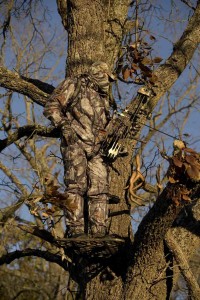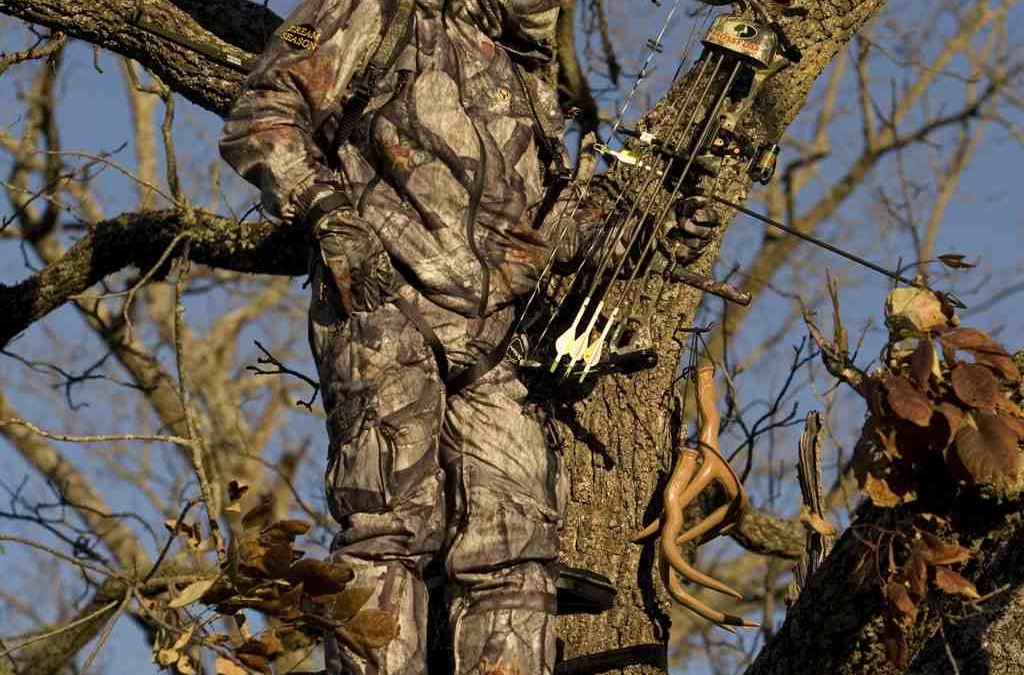
by Jackson | Aug 2, 2015 | Hunting Tips
Essential Accessories For Bow Hunting
You’ve got the talent, you can hit the bulls-eye regularly from your preferred distance. You’ve got the desire and have found your ideal hunting area and have identified your desired prey. To assist in locating your prey, you may choose to use trail cameras or other optical accessories. To learn more about these read my review here.
However you can’t really succeed at bow hunting without the right types of equipment. The key to hunting is not only skill and technique, but ensuring that your equipment is appropriate for the type of hunting you’re doing. Do you need a blind/hide or tree stand or are you going to try the stealth approach to your prey? These are some of the questions that you need to answer before you head out for your hunt. Think outside the box and be try to think like an animal. What would you do in order to hide from a hunter? What places may seem secure and undisturbed by hunters? To these questions and more you’ve found the answers in the right place.
Camouflage Clothing
Ready to hunt like you’ve never hunted before? Pretend you’re a tree? A bush? See your success rate improve dramatically.
The most important thing with regard to bow hunting is the ability to remain undetected by your prey. Whatever camouflage clothing your get it needs to blend in with the environment that your are hunting in. The main thing is to break up the human shape and not to alert your prey to your location, whether by movement, sound, smell or sight. Therefore your need to have a plan to cover all these areas.
For camouflage clothing suited for a woodland environment consider the following. Look no further than the Mossy Oak Break-Up Infinity pattern or the Realtree Xtra pattern, these are available for a variety of manufacturers.
If you are hunting out in the open then maybe a ghillie suit will be a better solution. Turn from human into ground cover within seconds, and they come in a variety of color ranges from snow to woodland. It’s the ultimate in 3D camouflage concealment. To read more about ghillie suits and hunting with ghillie suits, have a look at bestghilliesuit.com
Walkie Talkies
Walkie Talkies are a perfect edition to your bow hunting kit, this is especial the case when hunting in pairs. It can be essential to stay in contact, particularly if your hunt is covering some distance. You may want to consider a long range walkie talkie something suitable to talk over a vast miles and cover mountainous terrain. Reporting back to your group or the ability to radio for help could literally be the differences of a life or death situation in the outdoors.
Animal Callers
Why wait for the animals when you can get the animals to come to you!
Walsoon CP550 Outdoor Wireless 10W Speaker Turkey Decoy Bird Caller
The Walsoon CP550 Outdoor Wireless 10W Speaker Turkey Decoy Bird Caller is perfect during thanksgiving and delivering a special fresh turkey to the dinner table. Not only does it take care of turkey’s, but has more than 400 sounds of different animals and birds that will make the job so much easier. Wireless remote control, both in synchronization, react sensitively, work up to more than 250 Yards.
But there is a simpler choice for those who are less experienced and aren’t ready to fork out a lot of money.
Summit Zillions Deluxe Animal Caller
The Summit Zillions Deluxe Animal Caller is just one simple breath to create nature sounds and bring those animals coming. There are only 10 sounds to choose from, but it’s a way of easing into the world of hunting. On the plus side? It looks like a Viking horn. So Game of Thrones fans, get excited.
Scents and Baits
Another course of action to take is to try and bring the animals to you, by the use of scents and baits. These will have the benefit of luring your prey to a certain spot. If the area looks to be animal-friendly or you have identified animals in the area, leave bits of food and find somewhere to hide and wait. Depending on your intended prey, ensure that you leave the right type of bait. It is however worth noting that leaving the right type of bait will ensure that you hunt only the specific animal you intended to. Some of the more popular varieties are:
Or you could try a scent as you attractant
For those that want to try some simple attractants from your home pantry, you could try peanut butter or vanilla extract
Tree Stands or Blinds
As we said at the beginning of this article, your success with hunting depends largely on your ability to remain undetected by your prey. Therefore a means to hide your presence is essential. You may like to look at the following blinds and tree stands as a means to achieve your objective.
With all stands and blinds, it is worthwhile remembering how long you may lay in wait for your prey. Seriously think about a suitable seat to allow you to remain vigilant and comfortable. Remember your movement and sounds will also alert your prey even if you a secreted in your blind.
Conclusion
If you’re in a location that is renowned for its hunting ground, find a particular spot and lay low till you begin to hear any sort of rustling. Use your animal caller to seek out and bring it closer to you, but remember to lay low and hold your position. You may try this on a tree, rock, bushes, or near a cave site. The waiting game is always the hardest, and at the end of the day, you may leave with nothing. So be patient and keep trying. As they say, patience pays and all you need for a successful hunt is patience, apart from your bow and arrow.
When hunting in any setting, it’s a requirement to stay quiet, watch where you step, and ensure that there are no humans within the of your intended hunt. For example, as you come close to a deer, take deep breaths and remember to have your equipment ready. Aim as if you’re about to win gold in the Olympics. Take a deep breath and pull, steady yourself, and release the arrow at your target. Always remember to take that deep breath and release when shooting. It not only helps you stay calm, but the aiming process means you’ll be steady and not shaking or feeling the pressure to shoot.
Good luck
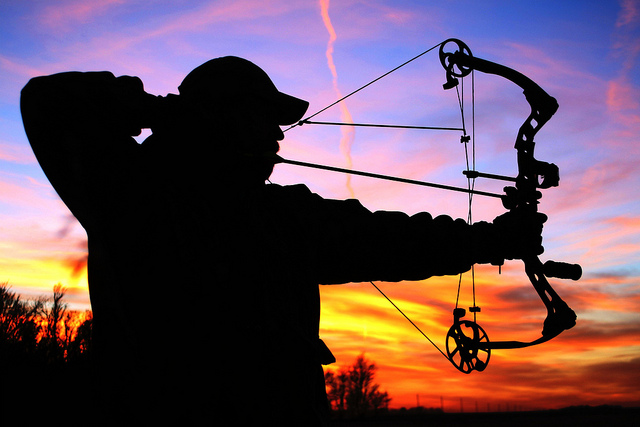
by Jackson | Apr 25, 2015 | Hunting Tips
A Beginners’ Guide to Bow Hunting
Bow hunting and archery are some of the greatest passions you can ever have in life. In fact, bow hunting is one of the fastest growing sections of the hunting industry. The challenge of successful bow hunts is unparalleled in the world of sports, and the reward that comes with a successful hunt is one that you’ll live to cherish forever. Bow hunting presents far more challenges than hunting with a gun, however, this means that it is so much more rewarding.
One of the advantages of bow hunting is that you get an earlier start to the season, that gets you out in the woods earlier . These are usually some of the prettiest times in one’s life, given that the weather is reasonably warm and the leaves are turning during bow hunting seasons.
Several states have opened their bow hunting seasons to crossbows, although there are usually some age restrictions. As a beginner, you may be tempted into following the easy route of hunting using a crossbow instead of learning to shoot a traditional or compound bow, given that the use of crossbows require little skill. As always you need to abide by the relevant by-laws covering bow hunting.
Bows for hunting
Using a bow as your weapon of choice when hunting, provides for much more satisfaction and enjoyment when successful in bagging your prize. This is because the skill level of the hunter needs to be so much greater than when using a gun. This is mainly because of the range of the weapons used and their accuracy over the normal distances that hunting occurs. Learning to shoot with a traditional or compound bows opens up numerous hunting possibilities, some of which are denied to those who make use of a crossbow only.
The compound bow, for instance, allows you to shoot accurately enough to hunt within a matter of some few weeks. However, the more practice you have and the more proficient with the bow you are will greatly improve your accuracy when taking that all important ‘kill shot’. The best part about modern bows is that you don’t have to train and practice for months on end in order to become sufficiently proficient in hunting with a bow, again some practice in the off season remains important to maintain your skills. This is where 3D shoots or even practice down at the range becomes very handy. As with all new skills, practice is always the key to top notch performance. And even though you may find that you are shooting quite well most of the time at the very beginning, you’ll have to make it a habit to shoot consistently well and to shoot well under pressure is all important. This provides the consistency that is necessary to harvest game more regularly and humanely.
Before making the commitment to learning bow hunting, it would be best to know what you are actually getting into. Here are some bow hunting basics you ought to know as you pursue to acquire and sharpen your skills.
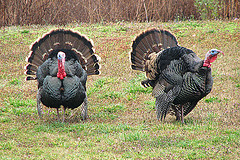
Wild turkey toms: photo by Vicki DeLoach
Bow Hunting Basics
There are three main types of skills you’ll have to develop as a bow hunter. They bear a high degree of importance and will help you in becoming a great bow hunter. They are as described below:
Before the shot– In order to acquire the opportunity to even take a shot, you’ll have to get close enough to your target and remain undetected. You should ascertain that you’re in a position where you can get a clean, unobstructed shot. A high level of accuracy, in terms of range estimation, is required. You should make sure to train to consistently and accurately judge the range. You can opt to make use of a laser rangefinder to help you in getting accurate shots. To read more about laser rangefinders click here.
Making the shot– Developing a good technique of shooting is the key to success, regardless of the range distance. Click here for techniques and tips on how to improve your accuracy. Regular and quality practice will certainly enable you to develop an appropriate technique. One single shot executed with solid technique is worth more than a hundred bad shots. So when practicing it is important that you view each shot as if you were actually hunting. Also it is good to practice beyond your own maximum range and focus on using the correct technique at all times. Longer shots will make shorter shots seem much easier.
After the shot– This welcomes you to another new aspect known as blood trailing. Making the shot accurately does not end the experience of bow hunting. Whilst we want every shot to result in a clean kill, unfortunately that is not always the case, sometimes there is a need to be able to track the animal. This process starts with blood trailing which involves observing the blood on the arrow to enable you determine the part of anatomy you’ve hit. Different colors will mean different organs. Getting knowledge on blood trailing helps you hone your hunting skills as you broaden your hunting opportunities.
Selecting a Bow
Majority of bow hunters make use of compound bows since they offer an extensive list of benefits, making them superior to other designs. They utilize a series of pulleys to create what is known as ‘let-off’. As you draw the string way back, the weight will let off, allowing you to hold the bow a lot longer at full draw, most compound bows have a let-off of around 70%.
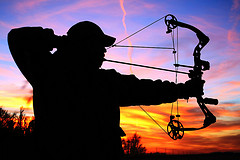
Bow Hunting by Kansas Tourism
The other types of bows, namely the longbows and re-curve bows, offer faster target acquisition and snap shooting. However, they don’t have let-off and may be less accurate at longer distances, requiring you to practice even more in order to master.
The most appropriate bow for you would be one that fits, having the right draw weight and draw length. If using a release aid, ensure to have it handy when testing the draw length. You should avoid getting too hung up on the many brands available and instead choose according to your preferences.
To read more on choosing your bow click here. You can also check out our reviews of various bows and equipment that we have carried out.
Tips for New Bow Hunters
Now that you’re rigged and ready, it’s important to get off with your shooting form on the right foot. Below are some tips for new bow hunters that will prove handy as you seek to sharpen your hunting skills.
Relax– you should learn to relax all muscles that are not required in holding the string back fully to ensure that your sight stands the best chance of settling on your target and isn’t jumping around.
Focus on your follow-through – Keep the bow intact in the aiming position till the arrow hits the target. You may not be able to do it entirely, but the mere effort of trying helps keep you on your target better, maintaining a more consistent follow-through.
Finding a good trail– You should keep it simple when hunting. You can find a good trail between a bedding and feeding area which is in a location you know you can get to and from without being detected.
Know your effective kill range (EKR) – This is the magical distance that you are sure to hit your target even under extreme pressure. This distance varies from individual to individual. It is thus up to you to find out what your EKR is. Once you limit yourself to this distance, you’ll be ultimately confident to always succeed.
How to Improve Your Bow Hunting Success
As a bow hunter, you’ll always feel challenged to bring your A-game. Lots of things will tend to cross your mind as you anchor and aim an arrow. Most of such things will be right. Some may be perfect. This one split-second culminates months of preparation, practice and planning. Here are some things you should take into consideration. With them, you’ll know be able to know how to improve your bow hunting success.
Accuracy is paramount– This is the aspect that matters most. Not the given bow’s accuracy, but your accuracy with a certain bow. The first trick to this is finding a bow that you can shoot accurately with, and then shooting it until you’re perfect. You should not even think of giving up accuracy for speed.
Speed– Once you’re able to shoot accurately, you’ll find that a faster bow bears several major benefits. One of them is that you’ll now enormously simplify things in the field. It also grants you the ability to shoot a heavy arrow sporting a heavy head without giving up a lot in trajectory. This guarantees more momentum and better penetration.
Accessories– It is much easier to accessorize for accuracy if need be. The right accessories will improve your shooting regardless of your skill level. The choice of accessories you get to pick depends solely on your preferences.
Proper stand placement– Every bow hunter ought to be aware of the basics involved in choosing a stand site. Placing your stand directly on trails or over scrapes is not always advisable. As you seek to select a proper stand site, make sure to check for secondary, paralleling trails.
Training to make better shots– Bow hunting requires proper planning and hard work in order to execute accurately. However, all these may be futile if your body can’t handle the ultimate test of accurately shooting your bow. You should tune your body to properly shoot a bow.
Final Note
Tradition is the biggest part of this sport. Every time you are in the field with a bow, you are taking time, money, effort and the mystique years of archery evolution has given us. On the field, you get to represent what many would consider to be the purest form of hunting. It is imperative that you take the above points into consideration, especially if you’re hoping for success in bow hunting.
If you want to learn more on either the basics of bow hunting click here, or even check out our reviews on archery and hunting equipment
I hope you have found some useful information from this beginners guide to bow hunting.
Happy hunting

by Jackson | Mar 17, 2015 | Hunting Tips
It’s been rather rainy and cold over the last several days. After being stuck inside so much, sometimes it’s just nice to get outside and do something and to stretch my legs. It was one of these moments just a few days ago that I had a small revelation and joy that I wanted to share.
I was out walking around a lake that’s very close to my house and I was just going around and hiking. I’m a fan of hiking and it’s an easy way to get out a bit and relax. As I was going, I saw some tracks in the mud. I’m always a bit curious when I see tracks because I want to know when they were made and what kind of animal it was.
There are lots of places where you can go to learn this information, but it’s pretty neat looking back that I could figure out what kind of animal it was and what direction it was going in. Later on when I was hiking back out I found some more stuff that was neat.
I found a bedding area and then also an area that had been recently scavenged through with all sorts of grasses bent and moved out of their normal place. I’m not an expert by any means, but I do know that this is one of those fun skills that you can do and keep entertained all year-long and you don’t think about getting better at it, but when it comes time to put that information to work that it’s really helpful.
Tracking and the Art of Seeing: How to Read Animal Tracks and Sign
The above link is to a book on tracking. I briefly read through bits here and there over the course of a year. I never really went in-depth on studying it really good except to tell the difference between hogs and deer. It’s kind of neat what you pick up though. To look around for damaged limbs, scat, or scrapings that can help you figure out what happened is a neat skill to pick up.
It sure makes me feel like I’m a better outdoorsman. I really don’t think I’d ever need to know how to survive in the wild to live there, but then again, no one ever plans on being forced to. Without being forced to study it, I liked it and when I found something that I didn’t know, I could just come back and take a quick look to see what I thought it was.
So that’s my rainy day archery story. Sorry if it wasn’t super exciting, but I really enjoyed being out side walking around and felt that just the smallest bit of extra knowledge made it more enjoyable.
Anyways, just a thought on how doing small things throughout the year can help you learn more and be a better outdoorsman with just a few minutes a month.

photo credit
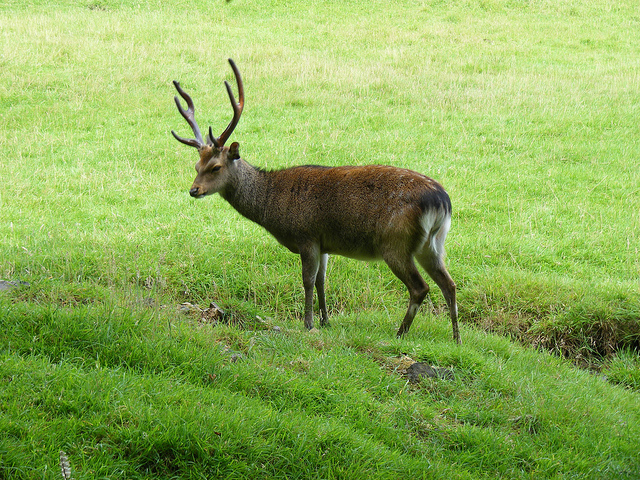
by Jackson | Oct 10, 2014 | Hunting Tips
Going out hunting can be a fun experience and having a good first experience can really help you love the experience even more. I’d like to share some bow hunting tips for beginners that should help you have a better first experience. I’m sure you already know it’s going to be a challenge, but there are lots of people who have great successful hunts all the time so you should feel confident that you can too.
These are some tips that are really good for beginners. I know that it would have helped me out when I started bow hunting. It’s definitely different from using a gun and other forms of hunting so if you’ve hunted a different way, there are some differences that you need to know or think about. Now, let me present some tips for a better first time, or first few times as it often turns out.
My bow hunting tips for beginners
Know your effective distance – It’s important to practice shooting and make sure that you can make a good shot when it counts. The other part of that equation is knowing how far you can shoot and have it be a really good shot. Let’s say that you’ve practiced for a while and the farthest you can shoot a really good group is at 25 yards. When you’re hunting, you should not shoot at anything that is beyond 25 yards. Making a bad shot is much worse than not taking a shot in the first place.
Use markers for everything – I recommend using a marking system for lots of things. First, I use it to know distances to spots around the hunting stand to help me out. You can mark trails so you don’t get lost or can at least find your way back. You can use something to help you figure out what direction the wind is going.
Take a practice round – If it’s your very first time, your on your own, or just want to see how it will go, then I highly recommend this. Go out to your hunting stand and take a target, then set it up where you expect the deer to be and go through the motions of getting in your stand and taking a shot. The entire experience could be better if you’re more comfortable and have a better idea of what to expect. I’d really recommend this if it’s your first time using a tree stand too.
Make a small goal you can get – The goal is to harvest an animal with a clean shot. If it’s your first time or you’re trying something different, then make a small goal for that day to be something a little easier. Some goals could be, just seeing the animals, making a quiet entrance and exit, or practicing moving silently in a spot and stalk. Hunting will use many skills so you can practice more than one thing while your out.
Get a guided hunt – There’s nothing like helping your chances by getting professional help. You can get a better experience, really good information, and better chances of a successful hunt. If you are either an absolute complete newbie or will only hunt 2 days out of entire year, then I think guided hunts are a really useful thing to look into to make your time more rewarding.
Have an exit plan – It’s funny how many people have a plan to go hunting and get a deer or turkey, but have no idea what to do once they’ve actually got an animal. Be sure to plan on how you’re going to prepare the animal out in the field, how you’re going to get it out of the woods for processing and where you’re going to take it. You can either process it yourself or take it to a processor.
Try something different – By this, I don’t mean crazy different. I’m talking about common sense changes or approaches that can expose you to more opportunities. If you normally go hunt in the evening, then try going in the morning. If the wind changes directions, then try entering your hunting area from a different direction. Try building a second hunting blind location. Try patterning the deer in your area if you’ve never done that. Deer act differently based their environment and so should you.
As always, use common sense, be safe, and enjoy the great outdoors. It’s the only one we have so we have to take care of it. I hope you’ll find these bow hunting tips for beginners useful. Starting your journey can be quite challenging and that’s why I’m here to help.
photo credit
On a side note, If you found this useful, I’d really appreciate it if you would take a moment and share it with your friends or someone you think might find it useful.
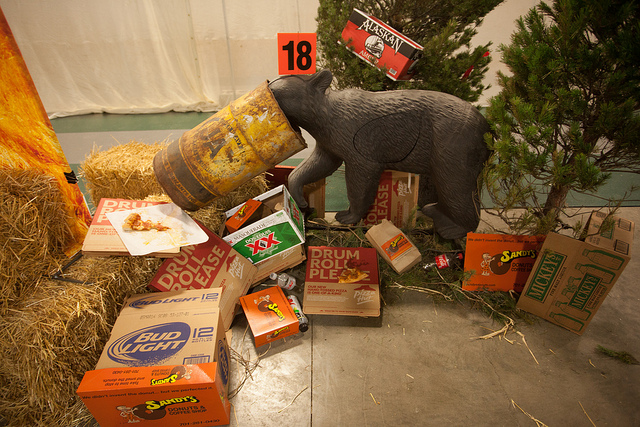
by Jackson | Apr 28, 2014 | Hunting Tips
I was sitting on the side of a hill waiting for the chance at my first deer. I was concealed by nothing but 4-5 shrub brushes pulled around my cousin and I. We sat there through the morning watching the brightening of the sky slowly spread its warmth across the ravine.
I slowly started seeing the light brown and gray colors moving in the distance. They are like ghosts appearing from nothing and acting as if they had never been anywhere else. I felt like they could hear the slightest sound and was even leery to blink at the thought of them hearing me. I didn’t know how I would act, but the adrenaline, focus, and intensity of all my senses seemed to be on edge.
The crosswind kept all of our smells away and I was good at moving silent. The only thing different was the shooting position. It was awkward, but I was determined and I had my cousin to make sure things went right so I wasn’t too worried. My shot was excellent and there would be no need for tracking. At the end after much of the emotion had faded was a resoluteness and sense of accomplishment and confidence that would last forever.
Perhaps your first hunting experience was like mine, perhaps not, but the tips and advice on how to go about it made a huge difference in my success. I’ve read lots of bow hunting tips throughout my life and many of them are very helpful, but I want to focus on some of the basic ones that will make you more successful a majority of the time. I love to focus on the basics, because the basics work and they work for almost everyone.
So without further squawking on the topic and in no particular order.
My 5 bow hunting tips to be successful
Practice shooting from a hunting position – The only time most people will ever shoot sitting down or leaning over is from the shooting stand. If you want to harvest an animal for months on end, then why would you only spend at most a week or two practicing shooting that very specific shot?
What makes more sense is to practice shooting that shot at least once or more per month, I recommend much more, so that you feel very comfortable with that shooting position. Having some new element thrown at you when you are out is not a good surprise most of the time.
Smells matter (most of the time)– A much debated topic and one that is truly valid. Bad and wrong smells can break your best hunting efforts. At the same time, I’m sure you’ll notice that there are lots of factors that go into smells, most important being wind. I recommend studying how the wind works in your hunting area.
On the opposite side of the fence is that smells don’t matter than much. Depending on where you are and what the deer are accustomed to can make a huge impact on how they react. They deer are more likely to react and leave the further away you get from any type of civilization. That being said, I’ve also seen deer stare at unnatural things for about 20 minutes and decide it’s harmless. They are fickle and tricky. I prefer the conservative side of removing as much unnatural smells as possible.
Noise makes a difference – Deer have big ears don’t they. I have made a noise with a deer call, a doe bleat to be exact, and had a buck walk to within 15 feet of where the sound came from. Their hearing is amazing and they are very good at figuring out the direction it came from. Having silent clothes and equipment will make a huge difference in a successful venture.
Safety saves – It’s basic and simple, but some common sense things can save you in most situations.
- Tell someone when and where your going hunting. Cell phones can get broken easily or have no reception.
- Make sure that all your equipment is in working condition and that you have at least a basic set of field tools with you.
- Have water and anything else you might want or need such as food, a hat, a compass, etc.
One good shot is better than a million bad shots – When it comes down to it. The most important part of the entire experience is making a good clean shot that is placed correctly. If there is any doubt that it is a bad shot or that something is behind the target, then don’t take the shot. You must make the decision and know what you are capable of as well as what you can not do. I’d love to hear your success story instead of how a poor decision made your hunt go wrong.
Hunting is a very complex skill that can take a long time to master, but if you’ll practice some of these bow hunting tips starting now, then you’ll be improving your chances of a wonderful hunting season in the future.
photo credit


